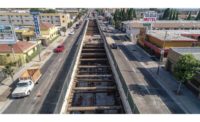$1.5-Billion Light Rail Line Takes Shape In LA

















Snaking above, below and through busy streets, sound studios, artist colonies and freeways, the extension of the Exposition Line from Culver City to Santa Monica is nearing completion thanks in part to the flexibility imparted by design-build, project officials say.
The 6.7-mile, $1.5-billion project includes seven bridges and seven stations squeezed into a busy urban setting. The light-rail system will use overhead catenary wiring for power, which required major utility relocations because California law prohibits placing high-voltage systems directly above areas where the public can congregate—such as open-air station platforms.
Moreover, the city of Santa Monica wanted the team to take the alignment down a narrow industrial street to accommodate plans for transit-oriented development. "That was very challenging, because now we needed to relocate all these utilities from underneath the street," says Brian Freund, project executive with Skanska USA's California division, which is in a joint venture with Steve P. Rados Inc.
The team's design-build contract has increased from $550 million to about $600 million due to "betterments"—requests from municipalities or agencies for changes beyond what contractors bid on at the 30% design stage, says Rick Thorpe, chief executive officer with the Exposition Construction Authority, an agency created by law and tasked with building the line that will be operated by Metro, the public transportation authority in Los Angeles. Requested changes include an aerial station rather than an at-grade station at a major intersection and a $16-million bike path.
The team worked almost two years just on coordination with utility companies while also proceeding with design and construction. Under a design-bid-build job, "we would now have just been starting construction," says Freund. Work began in 2012 but notices to proceed were limited at first, says Thorpe, as officials awaited the outcome of a failed lawsuit and appeal filed by one group of residents. That 3-year process ended last year.
The light-rail line follows an abandoned freight rail alignment, requiring crews to sometimes tear down or accommodate existing infrastructure with just inches of tolerance. For example, crews had to squeeze tracks under an existing box structure for the railroad that itself lies directly between the Interstate 10 freeway. "We would have had to shut down two lanes of the I-10 freeway for six to eight months if we had to reconstruct the box," says Thorpe.
Elevation varies, as the route goes over a major boulevard, then under the I-405, then up and over another busy street, notes Freund. Yet all the while the gradient that future trains can navigate cannot exceed 6%, says Thorpe. At one point, adds Freund, the gradient reached 5.95%.
Part of the alignment travels through an area chock-full of recording and post-production studios. To prevent train vibrations from hampering business, the team utilized in two areas a concrete slab that sits on springs. "We built a concrete bathtub U-section and cast individual elements that range from 30 to 60 ft long that sit on springs," says Freund.
Thorpe says the Expo line is the first North American transit system to utilize the GERB system, produced in Germany and used in heavy industrial facilities.
A test train will begin running in spring, and construction wraps up by fall.








